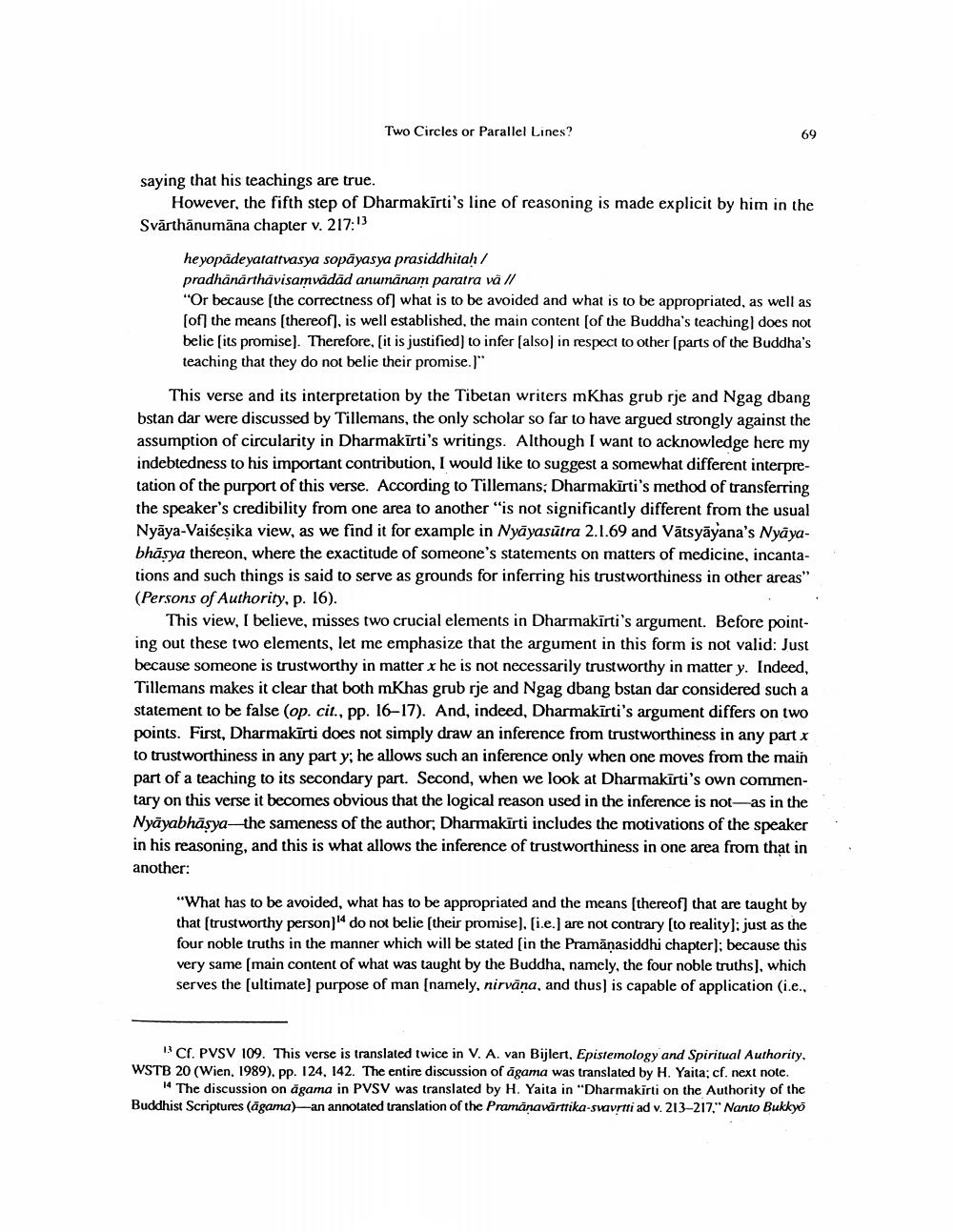Book Title: Two Circles Or Parallel Lines Author(s): Eli Franco Publisher: Eli Franco View full book textPage 7
________________ Two Circles or Parallel Lines? saying that his teachings are true. However, the fifth step of Dharmakirti's line of reasoning is made explicit by him in the Svārthānumāna chapter v. 217:13 heyopádeyatattvasya sopayasya prasiddhitah/ pradhanarthavisamvadad anumanam paratra va II "Or because (the correctness of what is to be avoided and what is to be appropriated, as well as (of the means (thereof), is well established, the main content (of the Buddha's teaching) does not belie (its promise). Therefore, it is justified) to infer (also in respect to other (parts of the Buddha's teaching that they do not belie their promise.)" This verse and its interpretation by the Tibetan writers mKhas grub rje and Ngag dbang bstan dar were discussed by Tillemans, the only scholar so far to have argued strongly against the assumption of circularity in Dharmakīrti's writings. Although I want to acknowledge here my indebtedness to his important contribution, I would like to suggest a somewhat different interpretation of the purport of this verse. According to Tillemans, Dharmakirti's method of transferring the speaker's credibility from one area to another is not significantly different from the usual Nyāya-Vaiseșika view, as we find it for example in Nyāyasūtra 2.1.69 and Vātsyāyana's Nyāyabhāsya thereon, where the exactitude of someone's statements on matters of medicine, incantations and such things is said to serve as grounds for inferring his trustworthiness in other areas" (Persons of Authority, p. 16). This view, I believe, misses two crucial elements in Dharmakīrti's argument. Before pointing out these two elements, let me emphasize that the argument in this form is not valid: Just because someone is trustworthy in matter x he is not necessarily trustworthy in matter y. Indeed, Tillemans makes it clear that both mKhas grub rje and Ngag dbang bstan dar considered such a statement to be false (op. cit., pp. 16-17). And, indeed, Dharmakirti's argument differs on two points. First, Dharmakirti does not simply draw an inference from trustworthiness in any part x to trustworthiness in any part y; he allows such an inference only when one moves from the main part of a teaching to its secondary part. Second, when we look at Dharmakīrti's own commentary on this verse it becomes obvious that the logical reason used in the inference is not—as in the Nyäyabhäsya—the sameness of the author, Dharmakīrti includes the motivations of the speaker in his reasoning, and this is what allows the inference of trustworthiness in one area from that in another: "What has to be avoided, what has to be appropriated and the means (thereof) that are taught by that (trustworthy person)" do not belie (their promise), i.e. are not contrary to reality): just as the four noble truths in the manner which will be stated in the Pramănasiddhi chapter]: because this very same (main content of what was taught by the Buddha, namely, the four noble truths), which serves the (ultimate) purpose of man (namely, nirvana, and thus) is capable of application (i.e., 13CL, PVSV 109. This verse is translated twice in V. A. van Bijlert, Epistemology and Spiritual Authority, WSTB 20 (Wien, 1989), pp. 124, 142. The entire discussion of agama was translated by H. Yaita; cf. next note. 14 The discussion on agama in PVSV was translated by H. Yaita in "Dharmakirti on the Authority of the Buddhist Scriptures (agama)—an annotated translation of the Pramanavärttika-svavrtti ad v. 213-217." Nanto BukkyoPage Navigation
1 ... 5 6 7 8 9 10
